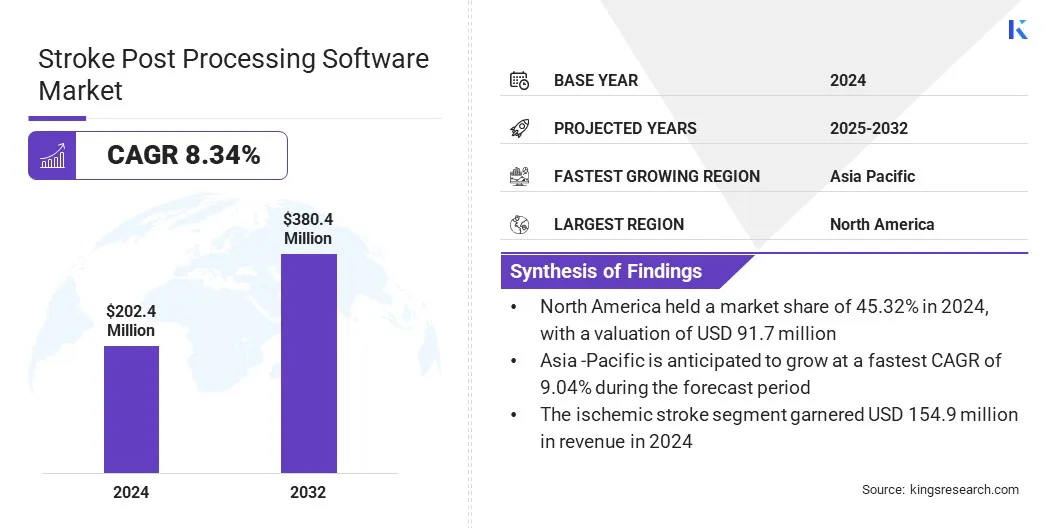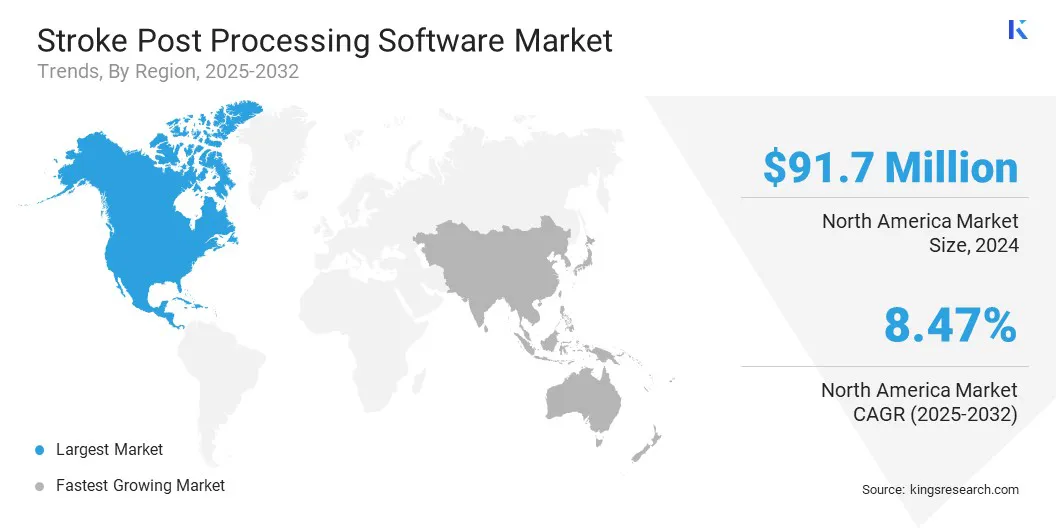Market Definition
Stroke post processing software is a specialized medical imaging solution designed to analyze and enhance diagnostic data from stroke-related scans, such as CT, MRI, and perfusion imaging. It assists clinicians in identifying stroke type, severity, and affected brain regions by providing automated image processing, advanced visualization, and quantitative analysis.
The market encompasses software tools that integrate with imaging systems, offer AI-powered decision support, and support more accurate stroke diagnosis and treatment planning in hospitals and diagnostic centers.
Stroke Post Processing Software Market Overview
The global stroke post processing software market size was valued at USD 202.4 million in 2024 and is projected to grow from USD 217.1 million in 2025 to USD 380.4 million by 2032, exhibiting a CAGR of 8.34% over the forecast period.
Market growth is driven by the adoption of AI-enabled automated imaging analysis, which enhances diagnostic accuracy, accelerates data interpretation, prioritizes critical cases, and reduces time-to-treatment. The rising demand for precision medicine and real-time clinical decision support in stroke care is further fueling adoption, as healthcare providers use advanced analytics and AI tools to personalize treatment pathways and improve outcomes.
Key Highlights:
- The stroke post processing software industry size was recorded at USD 202.4 million in 2024.
- The market is projected to grow at a CAGR of 8.34% from 2024 to 2032.
- North America held a share of 45.32% in 2024, valued at USD 91.7 million.
- The ischemic stroke segment garnered USD 154.9 million in revenue in 2024.
- The desktop-based software segment is expected to reach USD 233.6 million by 2032.
- The CT-scan segment is anticipated to witness the fastest CAGR of 8.53% over the forecast period.
- The hospitals & clinics segment held a share of 63.44% in 2024
- Asia Pacific is anticipated to grow at a CAGR of 9.04% over the forecast period.
Major companies operating in the stroke post processing software market are Brainomix Limited, iSchemaView, Inc, Nicolab B.V, Terarecon, Inc, Viz.ai, Inc, icometrix NV, CEREBRA.AI LTD, Aidoc Medical Ltd, Qure.ai Technologies Private Limited, General Electric Company, Siemens, Koninklijke Philips N.V, Canon Medical Informatics, Inc, Medtronic Inc, and Avicenna.AI.

The expansion of hospital infrastructure and adoption of advanced imaging systems is creating greater access to modern stroke diagnostic tools. Additionally, the growing focus on improving stroke care access in low‑ and middle‑income countries is boosting the adoption of advanced imaging and stroke post processing software solutions.
- In June 2024, Siemens Healthineers collaborated with the World Stroke Organization to improve global access to stroke care, with a focus on low‑ and middle‑income countries. The two‑year collaboration aims to strengthen clinical capacity through structured education, training programs, and stroke center certification.
Market Driver
Rising Global Stroke Incidence
A key factor driving the growth of the stroke post-processing software market is the rising global prevalence of stroke. Rising incidence of stroke, driven by aging populations and growing lifestyle-related risk factors such as hypertension, diabetes, and obesity is driving the demand for faster and more accurate diagnosis.
This is influencing healthcare providers to adopt advanced imaging and analytical tools, enabling early detection, improving patient outcomes, and supporting efficient stroke care management.
- Centers for Disease Control and Prevention (CDC) reports that stroke prevalence in U.S. adults rose from 2.7% (2011–2013) to 2.9% (2020–2022), a 7.8% increase, with the highest prevalence (7.7%) observed in adults aged 65 and older.
Market Challenge
Limited Interoperability with Existing Imaging Equipment and Hospital Systems
A key challenge impeding the growth of the stroke post processing software market is limited interoperability with existing imaging equipment and hospital systems. Many healthcare facilities operate on legacy systems that lack compatibility with advanced software solutions, creating integration difficulties. This results in inefficient data exchange, workflow delays, and increased operational complexity.
To address this challenge, market players are developing software solutions with enhanced compatibility and standardized integration protocols. Companies are developing vendor-neutral platforms that support multiple imaging formats and integrate seamlessly with hospital information systems (HIS) and picture archiving and communication systems (PACS).
They are also investing in cloud-based solutions and API-driven architectures to ensure seamless integration, improve workflow efficiency, and accelerate the adoption of stroke post processing software.
Market Trend
Increasing Integration of Artificial Intelligence and Machine Learning in Stroke Analysis
A key trend in the stroke post processing software market is the increasing integration of artificial intelligence (AI) and machine learning (ML) in stroke analysis. AI-driven platforms are enabling faster, more accurate interpretation of imaging data, supporting real-time decision-making for stroke diagnosis and treatment. Healthcare providers are adopting these technologies to enhance workflow efficiency, improve patient outcomes, and reduce time-to-treatment.
- In February 2024, UC Davis Health adopted Viz.ai’s AI-powered stroke imaging platform to rapidly analyze CT scans and alert care teams, enabling faster stroke diagnosis and treatment. This first deployment in the Sacramento region aims to improve patient outcomes and streamline stroke care through enhanced speed and coordination.
Stroke Post Processing Software Market Report Snapshot
|
Segmentation
|
Details
|
|
By Stroke Type
|
Ischemic Stroke, Hemorrhagic Stroke, Others
|
|
By Installation Type
|
Desktop-Based Software, Mobile Phones & Tablets
|
|
By Imaging Modality
|
CT-Scan, MRI
|
|
By End-User
|
Hospitals & Clinics, Specialty Centers, Others
|
|
By Region
|
North America: U.S., Canada, Mexico
|
|
Europe: France, UK, Spain, Germany, Italy, Russia, Rest of Europe
|
|
Asia-Pacific: China, Japan, India, Australia, ASEAN, South Korea, Rest of Asia-Pacific
|
|
Middle East & Africa: Turkey, U.A.E., Saudi Arabia, South Africa, Rest of Middle East & Africa
|
|
South America: Brazil, Argentina, Rest of South America
|
Market Segmentation:
- By Stroke Type (Ischemic Stroke, Hemorrhagic Stroke, and Others): The ischemic stroke segment earned USD 154.9 million in 2024 due to its higher prevalence and the critical need for rapid diagnosis and treatment.
- By Installation Type (Desktop-Based Software and Mobile Phones & Tablets): The desktop-based software segment held 62.35% of the market in 2024, due to its robust processing power and integration with hospital imaging systems.
- By Imaging Modality (CT-Scan and MRI): The CT-scan segment is projected to reach USD 279.0 million by 2032, owing to its wide availability, faster scan times, and cost-effectiveness.
- By End-User (Hospitals & Clinics, Specialty Centers, and Others): The specialty centers segment is anticipated to witness fastest CAGR of 9.61% over the forecast period, due to their focus on advanced stroke diagnosis and treatment capabilities.
Stroke Post Processing Software Market Regional Analysis
Based on region, the Market has been classified into North America, Europe, Asia Pacific, Middle East & Africa, and South America.

North America stroke post processing software market share stood at 45.32% in 2024 in the global market, valued at USD 91.7 million. This dominance is driven by the increasing prevalence of stroke among aging populations, which is creating greater demand for rapid and accurate diagnosis. The growing adoption of AI and ML in medical imaging is further accelerating market expansion by enabling real-time analysis and improving diagnostic accuracy.
Rising healthcare investments by governments and private healthcare providers in advanced imaging infrastructure are supporting market expansion. Additionally, regional players are focusing on strategic partnerships to enhance technology integration, expand service offerings, and improve stroke care delivery.
- In March 2024, Viz.ai collaborated with Medtronic to enhance postacute stroke care in the United States through the Viz Connect software platform. The collaboration aims to improve coordination between neurology and cardiology teams for cryptogenic stroke patients, enabling faster communication and guideline-directed therapy.
Asia Pacific is set to grow at a CAGR of 9.04% over the forecast period. This growth is attributed to the rising burden of stroke driven by increasing geriatric populations and a high prevalence of lifestyle-related risk factors.
Expanding healthcare infrastructure by governments and private healthcare providers is accelerating the adoption of stroke post processing software by improving access to advanced imaging systems and enhancing diagnostic capabilities. Additionally, growing focus on regional collaborations to improve efficiency and access to advanced stroke diagnosis and treatment is further propelling market growth.
- In March 2024, Qure.ai partnered with Medtronic India to deploy an AI-driven hub‑and‑spoke stroke care network at CMC Hospital, Ludhiana, to enhance stroke diagnosis and treatment in Punjab. The partnership aims to reduce time-to-treatment, improve diagnostic accuracy, expand access to advanced neurocritical care, and establish a scalable model for efficient stroke management across connected hospitals in the region.
Regulatory Frameworks
- In the U.S., the Food and Drug Administration (FDA) regulates stroke post processing software as a medical device under its digital health and software as a medical device (SaMD) framework. It oversees safety, clinical validation, performance, cybersecurity, and compliance with medical device standards to ensure accurate diagnostics and patient safety.
- In the UK, the Medicines and Healthcare Products Regulatory Agency (MHRA) regulates stroke post processing software as medical devices, ensuring safety, efficacy, clinical validation, cybersecurity, and conformity to regulations. It monitors performance and updates to maintain high standards of patient safety and diagnostic accuracy.
- In China, the National Medical Products Administration (NMPA) governs stroke post processing software by overseeing clinical trials, software validation, registration, manufacturing quality, and post-market surveillance. It ensures compliance with national health standards while promoting innovation and safeguarding patient care in diagnostic applications.
- In India, the Central Drugs Standard Control Organization (CDSCO) regulates stroke post processing software under the Medical Device Rules. It oversees product registration, safety testing, clinical validation, quality compliance, and post-market monitoring to ensure reliability, interoperability, and safety in healthcare delivery.
Competitive Landscape
Major players in the stroke post processing software industry are actively enhancing their software by integrating advanced AI and ML capabilities to improve diagnostic accuracy. They are expanding their presence through strategic partnerships and collaborations with healthcare providers and technology firms to enhance service delivery.
Companies are also investing in developing scalable, interoperable platforms that can seamlessly integrate with existing healthcare systems, enabling faster workflows. Additionally, they are focusing on creating integrated care models that combine imaging, analytics, and treatment coordination to streamline stroke management and improve patient outcomes across diverse healthcare settings.
- In February 2025, Brainomix partnered with Medtronic Neurovascular to integrate AI-powered stroke imaging with advanced neurovascular treatments. This collaboration aims to improve diagnostic accuracy and speed, enabling faster, more informed stroke treatment decisions.
Top Key Companies in Stroke Post Processing Software Market:
- Brainomix Limited
- iSchemaView, Inc
- Nicolab B.V
- Terarecon, Inc
- Viz.ai, Inc
- icometrix NV
- CEREBRA.AI LTD
- Aidoc Medical Ltd
- ai Technologies Private Limited
- General Electric Company
- Siemens
- Koninklijke Philips N.V
- Canon Medical Informatics, Inc
- Medtronic Inc
- Avicenna.AI
Recent Developments
- In April 2025, Brainomix received FDA clearance for a novel feature in its Brainomix 360 stroke post processing software. It enables the assessment of ischemic core volume from non‑contrast CT scans. This advancement allows physicians to make faster and more accurate treatment and transfer decisions in centers lacking advanced imaging capabilities.


